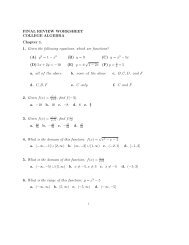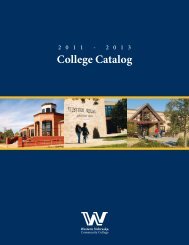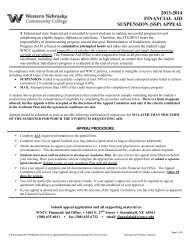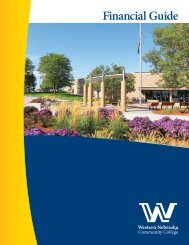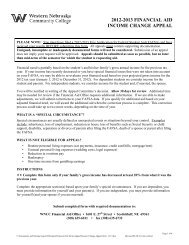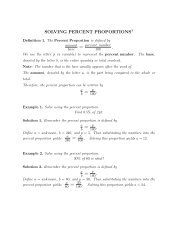WNCC 2010 Self-Study Report - Western Nebraska Community ...
WNCC 2010 Self-Study Report - Western Nebraska Community ...
WNCC 2010 Self-Study Report - Western Nebraska Community ...
You also want an ePaper? Increase the reach of your titles
YUMPU automatically turns print PDFs into web optimized ePapers that Google loves.
with retirements which occurred in the span of time since the last accreditation visit, the institution<br />
again faces significant numbers of potential retirements within the next 5 and 10 year categories.<br />
A chart below details those retirements as calculated by using age 65 as a primary indicator of<br />
retirement eligibility:<br />
Table 6-23 Retirement Eligibility (at age 65)<br />
Job Classification Over 65 Within 5 Years Within 10 Years<br />
Administrative 1 3 13<br />
Faculty 5 8 17<br />
Professional 1 3 4<br />
Support 1 8 14<br />
Of the current total of 191 full-time employees at <strong>WNCC</strong> (if the workforce composition remains<br />
fairly consistent), 40.8% of the current workforce will be eligible to retire within the next 10 years,<br />
including 30 of the 74 full-time faculty members and 17 of 33 employees in administrative positions,<br />
some of whom serve in executive leadership roles (RR 51). While retirements cannot be avoided,<br />
the turnover rate will mean that <strong>WNCC</strong> will need to create systems whereby the effect is lessened<br />
and whereby new faculty and staff members become contributing members of the institution<br />
relatively quickly and permanently.<br />
Institutional Change and Shared Governance<br />
The shared governance model at <strong>WNCC</strong> consists of three primary councils, Curriculum Council,<br />
Student Services Council, and College Council, along with several committees, task forces, and<br />
event teams. Institutional change is driven primarily through the three Councils, where Council<br />
members chart the course for the future of the institution, both short-term curricular adjustments<br />
and long-term changes such as programming or student policies.<br />
Students in the Service Region<br />
Besides the students from its district, the College draws students from adjacent states, as well as<br />
nationally and internationally. The greatest numbers of full-time students enroll from Scotts Bluff<br />
County. However, area high school recruitment visits occur on a regular basis in order to inform<br />
other students of the educational opportunity available within their district. Another viable target<br />
market is the Colorado/Front Range area, which shows great potential for growth in total<br />
population, besides the fact that Colorado community colleges are more expensive and many of<br />
them are at or approaching capacity.<br />
Out-of-state students represent a large block of students at <strong>WNCC</strong>, but the number is slightly<br />
deceptive because the total includes students enrolled through Corporate Academies, such as<br />
Cabela’s. A student may be in Virginia taking the course offered through the partnership, which<br />
means the student is registered as being out-of-state, although the corporate partner is<br />
headquartered within <strong>WNCC</strong>’s service area (the corporate headquarters for Cabela’s is actually<br />
located in Sidney).<br />
<strong>Western</strong> <strong>Nebraska</strong> <strong>Community</strong> College Page 83



